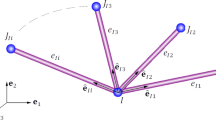Abstract
A recursive solution method is derived for the transient response of one-dimensional structures subjected to the general form of time-dependent boundary conditions. Unlike previous solution methods that assumed the separation of variables, the present method involves formulating and solving the dynamic problems using the summation of two single-argument functions satisfying the motion equation. Based on boundary and initial conditions, a recursive procedure is derived to determine the single-argument functions. Such a procedure is applied to the general form of boundary conditions, and an analytical solution is derived by solving the recursive equation. The present solution method is implemented for base excitation problems, and the results are compared with those of the previous analytical solution and the Finite element (FE) analysis. The FE results converge to the present analytical solution, although considerable error is found in predicting a solution method on the basis of the separation of variables. The present analytical solution predicts the transient response for wave propagation problems in broadband excitation frequencies.
Similar content being viewed by others
References
D. Beskos and G. Narayanan, Dynamic response of frameworks by numerical Laplace transform, Computer Methods in Applied Mechanics and Engineering, 37 (1983) 289–307.
Y. Ni, W. Lou and J. Ko, A hybrid pseudo-force/Laplace transform method for non-linear transient response of a suspended cable, Journal of Sound and Vibration, 238 (2000) 189–214.
A. Papoulis, A new method of inversion of the Laplace transform, Quart. Appl. Math, 14 (1957) 124.
F. Durbin, Numerical inversion of Laplace transforms: an efficient improvement to Dubner and Abate’s method, The Computer Journal, 17 (1974) 371–376.
S. S. Rao, The finite element method in engineering, Butterworth-heinemann (2005).
M. Eisenberger, Dynamic stiffness matrix for variable cross-section Timoshenko beams, Communications in Numerical Methods in Engineering, 11 (1995) 507–513.
J. Banerjee, Dynamic stiffness formulation for structural elements: a general approach, Computers & Structures, 63 (1997) 101–103.
R. Langley, Application of the dynamic stiffness method to the free and forced vibrations of aircraft panels, Journal of Sound and Vibration, 135 (1989) 319–331.
J. Banerjee and A. Sobey, Dynamic stiffness formulation and free vibration analysis of a three-layered sandwich beam, International Journal of Solids and Structures, 42 (2005) 2181–2197.
U. Lee, Vibration analysis of one-dimensional structures using the spectral transfer matrix method, Engineering Structures, 22 (2000) 681–690.
J. F. Doyle, Wave propagation in structures, Springer (1989).
S. S. Rao, Vibration of continuous systems, John Wiley & Sons (2007).
S. Pal, Explicit finite element modeling of joint mechanics, ProQuest (2008).
F. Moser, L. J. Jacobs and J. Qu, Modeling elastic wave propagation in waveguides with the finite element method, Ndt & E International, 32 (1999) 225–234.
D. Roy Mahapatra and S. Gopalakrishnan, A spectral finite element model for analysis of axial–flexural–shear coupled wave propagation in laminated composite beams, Composite Structures, 59 (2003) 67–88.
Author information
Authors and Affiliations
Corresponding author
Additional information
Recommended by Associate Editor Eung-Soo Shin
Mohammad Tahaye Abadi is an Associate Professor of Mechanical Engineering. He received his Ph.D. from Amirkabir University of Technology (Tehran Polytechnic), Iran in 2003. His research interests include composite materials, material characterization, viscoelastic materials, shock and vibration, and structural health monitoring.
Rights and permissions
About this article
Cite this article
Abadi, M.T. Recursive solution for dynamic response of one-dimensional structures with time-dependent boundary conditions. J Mech Sci Technol 29, 4105–4111 (2015). https://doi.org/10.1007/s12206-015-0904-5
Received:
Revised:
Accepted:
Published:
Issue Date:
DOI: https://doi.org/10.1007/s12206-015-0904-5




